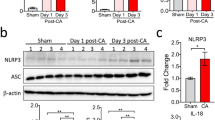Summary
The possible role of minocycline in microglial activation and neuronal death after cardiac arrest (CA) and cardiopulmonary resuscitation (CPR) in mice was investigated in this study. The mice were given potassium chloride to stop the heart beating for 8 min to achieve CA, and they were subsequently resuscitated with epinephrine and chest compressions. Forty adult C57BL/6 male mice were divided into 4 groups (n=10 each): sham-operated group, CA/CPR group, CA/CPR+minocycline group, and CA/CPR+vehicle group. Animals in the latter two groups were intraperitoneally injected with minocycline (50 mg/kg) or vehicle (normal saline) 30 min after recovery of spontaneous circulation (ROSC). Twenty-four h after CA/CPR, the brains were removed for histological evaluation of the hippocampus. Microglial activation was evaluated by detecting the expression of ionized calcium-binding adapter molecule-1 (Iba1) by immunohistochemistry. Neuronal death was analyzed by hematoxylin and eosin (H&E) staining and the levels of tumor necrosis factor-alpha (TNF-α) in the hippocampus were measured by enzyme-linked immunosorbent assay (ELISA). The results showed that the neuronal death was aggravated, most microglia were activated and TNF-α levels were enhanced in the hippocampus CA1 region of mice subjected to CA/CPR as compared with those in the sham-operated group (P<0.05). Administration with minocycline 30 min after ROSC could significantly decrease the microglial response, TNF-α levels and neuronal death (P<0.05). It was concluded that early administration with minocycline has a strong therapeutic potential for CA/CPR-induced brain injury.
Similar content being viewed by others
References
Rosamond W, Flegal K, Friday G, et al. Heart disease and stroke statistics—2007 update: a report from the American Heart Association Statistics Committee and stroke statistics subcommittee. Circulation, 2007,115(5):e69–e171
Rea TD, Eisenberg MS, Becker LJ, et al. Temporal trends in sudden cardiac arrest: a 25-year emergency medical services perspective. Circulation, 2003,107(22):2780–2785
Crepel V, Epsztein J, Ben-Ari Y. Ischemia induces short- and long-term remodeling of synaptic activity in the hippocampus. J Cell Mol Med, 2003,7(4):401–407
Yenari MA, Kauppinen TM, Swanson RA. Microglial activation in stroke: therapeutic targets. Neurotherapeutics, 2010,7(4):378–391
Tang M, Alexander H, Clark RS, et al. Minocycline reduces neuronal death and attenuates microglial response after pediatric asphyxial cardiac arrest. J Cereb Blood Flow Metab, 2010,30(1):119–129
Norman GJ, Morris JS, Karelina K, et al. Cardiopulmonary arrest and resuscitation disrupts cholinergic anti-inflammatory processes: a role for cholinergic alpha7 nicotinic receptors. J Neurosci, 2011,31(9):3446–3452
Sutherland BA, Minnerup J, Balami JS, et al. Neuroprotection for ischaemic stroke: translation from the bench to the bedside. Int J Stroke, 2012,7(5):407–418
Plane JM, Shen Y, Pleasure DE, et al. Prospects for minocycline neuroprotection. Arch Neurol, 2010,67(12):1442–1448
Hoda MN, Li W, Ahmad A, et al. Sex-independent neuroprotection with minocycline after experimental thromboembolic stroke. Exp Transl Stroke Med, 2011,3(1):16
Allen D, Nakayama S, Kuroiwa M, et al. SK2 channels are neuroprotective for ischemia-induced neuronal cell death. J Cereb Blood Flow Metab, 2011,31(12):2302–2312
Lalancette-Hébert M, Swarup V, Beaulieu JM, et al. Galectin-3 is required for resident microglia activation and proliferation in response to ischemic injury. J Neurosci, 2012,32(30):10383–10395
Prass k, Meisel C, Hoflich C, et al. Stroke-induced immunodeficiency promotes spontaneous bacterial infections and is mediated by sympathetic activation reversal by post stroke T helper cell type 1-like immunostimulation. J Exp Med, 2003,198(5):725–736
Zhang Z, Chopp M, Powers C, et al. Temporal profile of microglial response following transient (2h) middle cerebral artery occlusion. Brain Res, 1997,744(2):189–198
Lenglet S, Montecucco F, Denes A, et al. Recombinant tissue plasminogen activator enhances microglial cell recruitment after stroke in mice. J Cereb Blood Flow Metab, 2014,34(5):802–812
Kohman RA, Rhodes JS. Neurogenesis, inflammation and behavior. Brain Behav Immun, 2013,27(1):22–32
Pradilla G, Chaichana KL, Hoang S, et al. Inflammation and cerebral vasospasm after subarachnoid hemorrhage. Neurosurg Clin N Am, 2010,21(2):365–379
Yrjanheikki J, Keinanen R, Pellikka M, et al. Tetracyclines inhibit microglial activation and are neuroprotective in global brain ischemia. Proc Natl Acad Sci USA, 1998,95(26):15769–15774
Fagan SC, Waller JL, Nichols FT, et al. Minocycline to improve neurologicoutcome stroke (MINOS): a dose-finding study. Stroke, 2010,41(10):2283–2287
Qiu J, Nishimura M, Wang Y, et al. Early release of HMGB-1 from neurons after the onset of brain ischemia. J Cereb Blood Flow Metab, 2008,28(5):927–938
Aronowski J, Zhao X. Molecular pathophysiology of cerebral hemorrhage: secondary brain injury. Stroke, 2011,42(6):1781–1786
Lambertsen KL, Biber K, Finsen B. Inflammatory cytokines in experimental and human stroke. J Cereb Blood Flow Metab, 2012,32(9):1677–1698
Pola R. Inflammatory markers for ischaemic stroke. Thromb Haemost, 2009, 101(5):800–801
Drabek T, Janata A, Wilson CD, et al. Minocycline attenuates brain tissue levels of TNF-α produced by neurons after prolonged hypothermic cardiac arrest in rats. Resuscitation, 2014,85(2):284–291
Yenari MA. Han HS. Neuroprotective mechanisms of hypothermia in brain ischaemia. Nat Rev Neurosci, 2012,13(4):267–278
Trendelenburg G. Acute neurodegeneration and the inflammasome: central processor for danger signals and the inflammatory response? J Cereb Blood Flow Metab, 2008,28(5):867–881
Duan Y, Sahley CL, Muller KJ. ATP and no dually control migration of microglia to nerve lesions. Dev Neurobiol, 2009,69(1):60–72
Author information
Authors and Affiliations
Corresponding authors
Additional information
This project was supported by grants from the National Natural Science Foundation of China (No. 81201444 and No. 81101401).
Rights and permissions
About this article
Cite this article
Wang, Qy., Sun, P., Zhang, Q. et al. Minocycline attenuates microglial response and reduces neuronal death after cardiac arrest and cardiopulmonary resuscitation in mice. J. Huazhong Univ. Sci. Technol. [Med. Sci.] 35, 225–229 (2015). https://doi.org/10.1007/s11596-015-1415-4
Received:
Revised:
Published:
Issue Date:
DOI: https://doi.org/10.1007/s11596-015-1415-4




